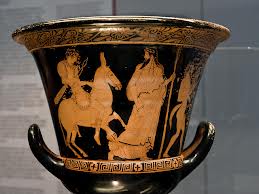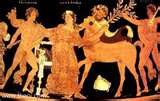Amongst the Hellenistic rulers referred to as Alexander's heirs only one seems to have been related to him -Ptolemy called Ptolemaios in Greek whose name derives from an archaic version of the spelling of polemos - war.
Rumor had it that he may have been Alexander's half brother and he was his cousin.
Just as many of the other generals adopted Persian and Asian costumes and customs alongside of their Hellenic heritage likewise in Egypt Ptolemy and his descendants depicted themselves as being as much Egyptian as Greek although none of the Ptolemaic dynasty is known to have intermarried with Egyptians.
Hence these two images of the first Ptolemy.
The dynasty seems to have had a genuine policy of supporting "multiculturalism" in Egypt with Alexandria attracting dozens of ethnic groups.
Perhaps this is why Egypt survived as an independent realm up to the time of the Caesars unlike other Hellenistic realms and empires?
More about Ptolemy in following blogs and others of Alexander's heirs.































